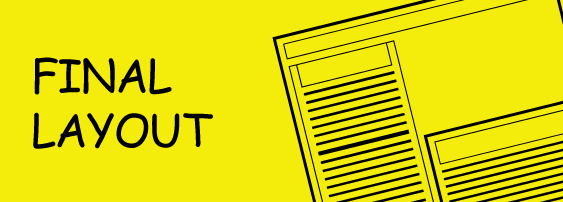Would you like to prepare an Newsletter, book or advertisement for your society or community? You have arranged photos, text matter and society logo. The size is also with you, it will take some amount of time to create the layout for your design. You have already learnt the principles of design, with a help of these basic tips you can easily prepared a good design layout and your society members also like it. You can send the final design to the printer for printing.
How to create a good layout?
First of all Planning!

Planning is must for any structure. To construct a building you need a plan chart, so you can arrange the whole thing before you start. Like a building, a graphic design is also a structure. A design planning know as a layout. To prepare layout for your design you need photo or illustration, headlines and copy, logo and another details. Now you can plan to design an advertisement as per your requirement with available space.
Scribble your idea on paper...

After spending a lot of time, You have prepared the design. Ohh no... you find that some pictures missed out and the logo also need to increase. Now to include the pictures and logo expansion, you have to arrange the whole design again. This type of situation could be avoided, if you had first developed your idea in you mind and put the rough sketch on the paper that gave the basic compositional arrangement. With this rough sketch you can try various alternative options which suit to your requirement.
Final layout
The next step is to create a proper page layout for your design. The term “page layout” is used simply to describe the way text and images are situated on a page. For professional look and feel, you should follow these basic things when doing the layout.
Alignment: If you go for center alignment, it will give formal look. Generally used for personal announcement, wedding cards, etc. Left alignment will give a professional look. When you want clean and well order layout, you can try Full alignment. With this you can try the heading / photos left, right or centered.
Bitmap pictures are stored as a vertical and horizontal array of Pixels and stored information represents the colour of each of these pixels. The resolution of a bitmap picture describes how many of these pixels exist over a set distance, usually horizontally: ie pixels per inch or pixels per centimeter. An unaltered bitmap picture of 300 pixels / inch enlarged by 1000% will therefore still have the same number of pixels across the actual picture area but each represented pixel will cover a larger area.Your page layout should be visually appealing and keep the readers interest. You can make your page noticeable by using of font style & size, and colour. Use a contrasting typeface and colour for headings and keep them very different from part of design.
Type: Type is very important element in layout, so always use an easy-to-read typeface. For legible text we need topographies with a simple fonts without complex details. The reader should pay attention to the content and not the text. If you have lot of text matter then avoid using a light version of a type face because reading of this text will probably become tiring and nobody will want to read it.
Avoid using many type faces in single design Job, it create confusion.
Always set the font size against importance of information. What should right size of type? newsletters are 10-, 11- or 12-point. Type sizes for presentation graphics, posters and displays should be larger. For Example of A4 advertisement. The type should be : Heading: 30 pt., Sub Heading: 22 pt., Body Matter: 12 pt., Address Portion: 8 pt.,
Color : Use colour to catch reader's attention and also as a tool for directing the viewer's through the message. Pick colors for type and illustration that match well with the background color. Despite of using multiple colours, a simple color scheme of 2 or 3 colors, with only one of the colors being a highlight color, can often communicate more effectively.
Margins: Margins are the imaginary vertical limits for text columns. Establishment of margins is very carefully job. The white space surrounding printed material effects both appearance and the readability of the layout. Big amount of marginal space indicates luxury or formality; small margins indicate commercialism. For example, a dictionary utilize more than 85% of the paper for type. Whereas, a product catalogue utilize 30% of the area for type, leaving 75% for margin.








No comments:
Post a Comment